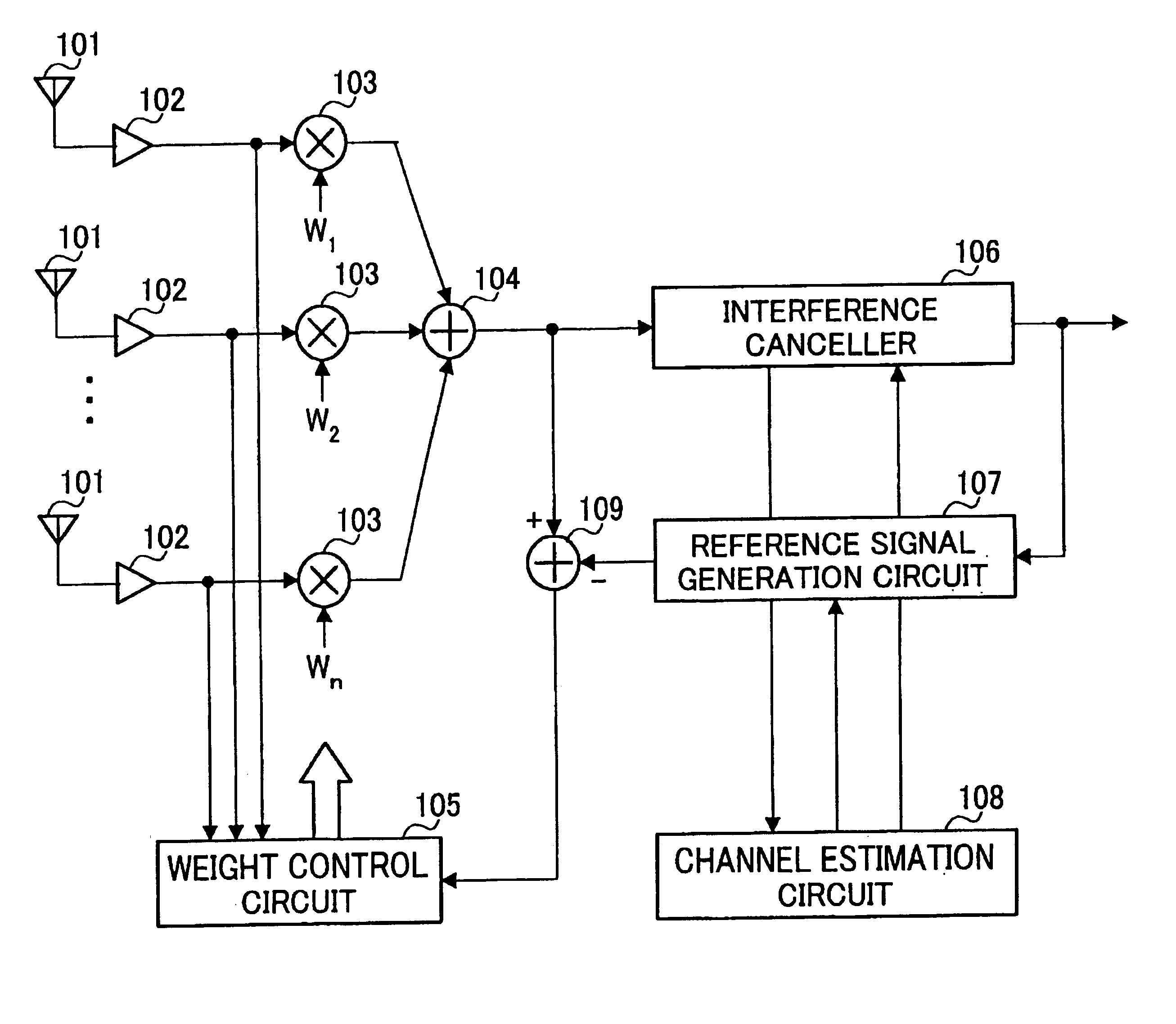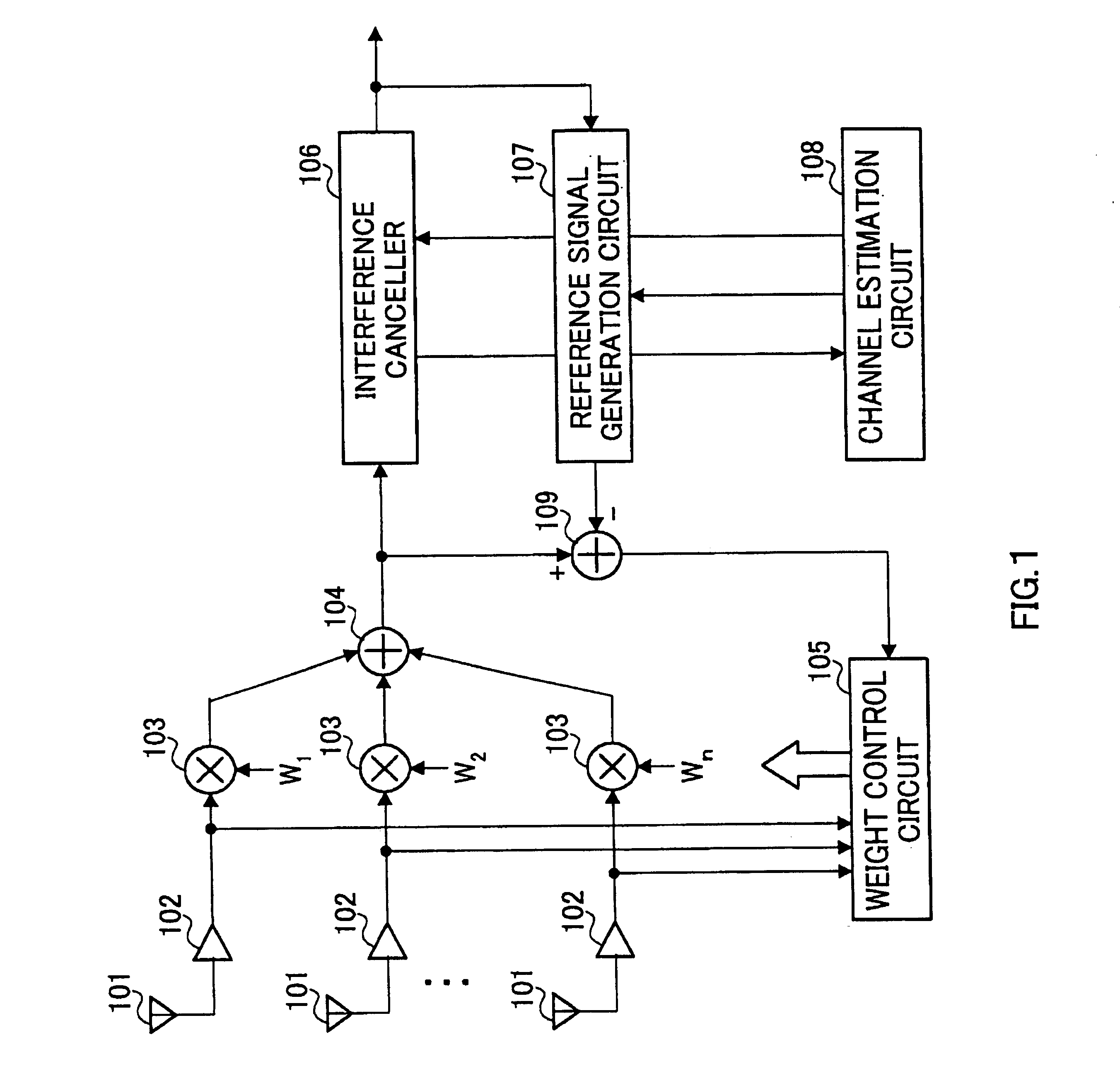Radio base station apparatus and radio communication method
a radio communication and base station technology, applied in multiplex communication, polarisation/directional diversity, wireless communication services, etc., can solve the problem that corresponding to n channels will require an amount of processing corresponding to (n direction patterns)m, and achieve the effect of improving the reception characteristic and increasing the system capacity
- Summary
- Abstract
- Description
- Claims
- Application Information
AI Technical Summary
Benefits of technology
Problems solved by technology
Method used
Image
Examples
embodiment 1
(Embodiment 1)
[0021]FIG. 1 is a block diagram showing a configuration of a radio base station apparatus according to Embodiment 1 of the present invention. The radio base station apparatus according to this embodiment carries out group directivity control using a signal subjected to interference canceller processing as a reference signal and using a difference between the reference signal and the post-AAA reception signal as an error signal.
[0022]A signal received through antenna 101 is subjected to predetermined radio reception processing (down-conversion and A / D conversion, etc.) and converted to a baseband signal at radio reception processing section 102. This received data (baseband signal) is sent to weight control circuit 105 and multiplier 103 at the same time.
[0023]Weight control circuit 105 estimates the direction of arrival from the received data and carries out reception weights corresponding to the received data using the result of the direction of arrival estimation. Th...
embodiment 3
(Embodiment 3)
[0054]This embodiment describes a modification example of the radio base station apparatus of the present invention. FIG. 4 is a block diagram showing a configuration of a radio base station apparatus according to Embodiment 3 of the present invention. In FIG. 4, the same parts as those in FIG. 1 are assigned the same reference numerals as those in FIG. 1 and detailed explanations thereof will be omitted.
[0055]First, a modification example of replica signal generation will be explained. The following three methods are available to generate a replica signal:
[0056](1) Using only known signal after interference cancellation processing (e.g., pilot signal)
[0057](2) Using provisional decision signal of information data in addition to pilot signal
[0058](3) Using output of error correction(FEC) / decoding circuit 401 or decision data (after deinterleave+error correction(FEC) / decoding in general) when information data section is used
[0059]In this method, a control delay increase...
embodiment 4
(Embodiment 4)
[0073]FIG. 6 is a block diagram showing a configuration of a radio base station apparatus according to Embodiment 4 of the present invention. In FIG. 6, the same parts as those in FIG. 1 are assigned the same reference numerals and detailed explanations thereof will be omitted.
[0074]This embodiment describes a radio base station apparatus that uses a signal subjected to interference canceller processing and then error correction(FEC) / decoding as a reference signal and carries out group directivity control using a difference between the reference signal and a post-AAA reception signal as an error signal.
[0075]The operations after the signal from the communication terminal is AAA received by antenna 101 until the signal is subjected to interference cancellation processing at interference canceller 106 are the same as that in Embodiment 1.
[0076]The demodulated data subjected to interference canceller processing is sent to de-interleaving circuit 601, deinterleaved there a...
PUM
 Login to View More
Login to View More Abstract
Description
Claims
Application Information
 Login to View More
Login to View More - R&D
- Intellectual Property
- Life Sciences
- Materials
- Tech Scout
- Unparalleled Data Quality
- Higher Quality Content
- 60% Fewer Hallucinations
Browse by: Latest US Patents, China's latest patents, Technical Efficacy Thesaurus, Application Domain, Technology Topic, Popular Technical Reports.
© 2025 PatSnap. All rights reserved.Legal|Privacy policy|Modern Slavery Act Transparency Statement|Sitemap|About US| Contact US: help@patsnap.com



